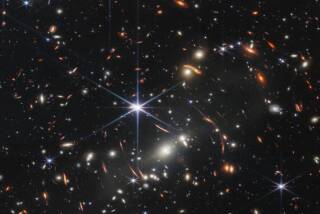Planck: Big Bang’s afterglow reveals older universe, more matter
- Share via
The universe has hidden its age well. The European Space Agency’s Planck space telescope has scanned the skies for the Big Bang’s fingerprint and discovered that the universe is about 100 million years older than thought, and that there’s more normal matter and dark matter filling the cosmos.
The findings announced Thursday by ESA and NASA peg the universe’s age at 13.8 billion years, and produced a multicolored map showing the tiny temperature fluctuations that reveal the seeds of the universe’s future structure.
“It might look a little bit like a dirty rugby ball or a piece of modern art,” ESA’s George Efstathiou, a Cambridge University astrophysicist, said in a press conference early Thursday morning. “But I can assure you there are cosmologists who would have hacked our computers or maybe even given up their children to get hold of a copy of this map.”
March Madness puts Davidson math professor in a bracket of his own
The Planck mission is a successor to NASA’s Wilkinson Microwave Anisotropy Probe (WMAP) and the Cosmic Background Explorer (COBE), and it takes our snapshot of the early universe’s afterglow to unprecedented clarity.
“It’s as if we’ve gone from a standard television to a high-definition television,” NASA astrophysics director Paul Hertz said in a later press conference. “New and important details have become crystal clear.”
The map represents the first 15.5 months of observation by the Planck space telescope, which looked at the universe’s cosmic microwave background -- that extremely cold, barely noticeable glow left after the Big Bang when the universe was just a cosmic baby -- about 380,000 years old.
Although it’s cold now, this afterglow is an imprint from when the young universe’s soup of particles heated to about 4,900 degrees Fahrenheit, stretched across the skies during a period of expansion known as inflation, and cooled over the intervening billions of years to just a few degrees above absolute zero.
Since the light’s path is affected by all the mass around it, the new radiation map also allows scientists to create a map of all the mass in the universe, scientists said.
“We can see the subtle effects of the gravitational pulls from literally everything in the universe,” said U.S. Planck project scientist Charles Lawrence, based at Jet Propulsion Laboratory. “That tells us about ... everything in the universe.”
The researchers found that they could raise the estimates of normal matter in the universe to 4.9%, up from 4.6%. The dark matter share rose to 26.8%, up from 24%. The overwhelming majority, dark energy – that strange force that’s causing the universe to expand faster and faster – shrunk accordingly, from 71.4% to 68.3%.
And with less dark energy to push things apart, the universe isn’t expanding quite as quickly as thought, the scientists found.
The map is colored in shades from blue (for colder spots) to yellow to red (for warmer spots). But the differences between cold and warm are infinitesimally small, on the order of 100 millionths of a degree.
“The contrasts are turned way up,” Lawrence said.
The Planck spacecraft’s data also highlight two other mysteries: why the heat from the background radiation isn’t evenly distributed, and what could have caused a strange cold spot in the map, now revealed to be even larger than previous estimates.
Follow me on Twitter @aminawrite.





